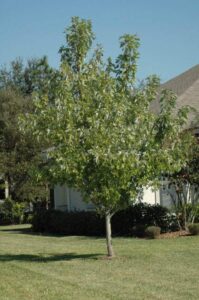S & J Nursery’s Guide to Growing
Silver MapleTree
in the Northeast Florida Landscape
( Acer Saccharinum )
Silver Maple Origins:
– Native to the eastern North America including Northern Florida.
Silver Maple Preferred Exposure:
– full sun to light shade
Silver Maple Foliage | Bark:
– deciduous foliage of the Silver Maple tree is a medium green color on the leaf surface and a silvery green underneath giving the tree beautiful shimmer with even the slightest of breezes.
– Leaves change to a pale yellow in fall just before leaving the tree for the
winter.
– Silver Maple’s bark is a silvery gray color and peels in long strips on mature trees.
Silver Maple Soil Preference / Salt tolerance:
– tolerates a wide range of soil composition and PH conditions
– although drought tolerant once established Silver Maples will thrive in areas with extended flooding along embankments or low wetland areas with poor drainage that other trees will not tolerate at all.
Silver Maple Size Variance:
– Silver maples have a wide range of genetic diversity and may range in size from 60-80+ feet H | 40-60+ feet W depending on environmental factors
Silver Maple Growth Habit:
– upright narrow growth habit with a slightly vase shape, taller than it is
wide
Silver Maple Growth Rate:
– extremely fast growth rate
Silver Maple Bloom:
– Bright red blooms in early spring
Silver Maple Water Requirements:
– drought tolerant once established, but will grow wonderfully in extremely
wet soils
Butterfly or Bird Attracting:
– n/a
Best Uses For Silver Maple:
– Silver Maple is an excellent choice for a shade tree in low lying areas where other trees will suffer due to high water levels and lack of drainage.
Care of Silver Maples:
– water every day during the establishment period. See watering your newly planted trees for more information.
-they will need good water during the establishment period and supplemental irrigation during dry spells or particularly hot dry summers.
– pruning is particularly important on a Silver Maple tree, the extremely fast growing tree tends to be soft wooded and can split and drop limbs during storms especially in trees where care has not been taken to remove damaged limbs or limbs coming off of the trunk at an angle less than 45
degrees forming a weakened crotch angle that will decrease the strength of the joint and cause breakage at that point.
– provide a 1 ft diameter circle of mulched area where grass is kept from growing for each inch of caliper (or diameter) of trunk measured 4 inches from the ground level.
– fertilize each spring with a mixture of Milorganite and a slow release poly coated plant food such as Osmocote or Stay Green general purpose plant food, sprinkling the fertilizer around the mulch circle underneath the foliage of the tree.

